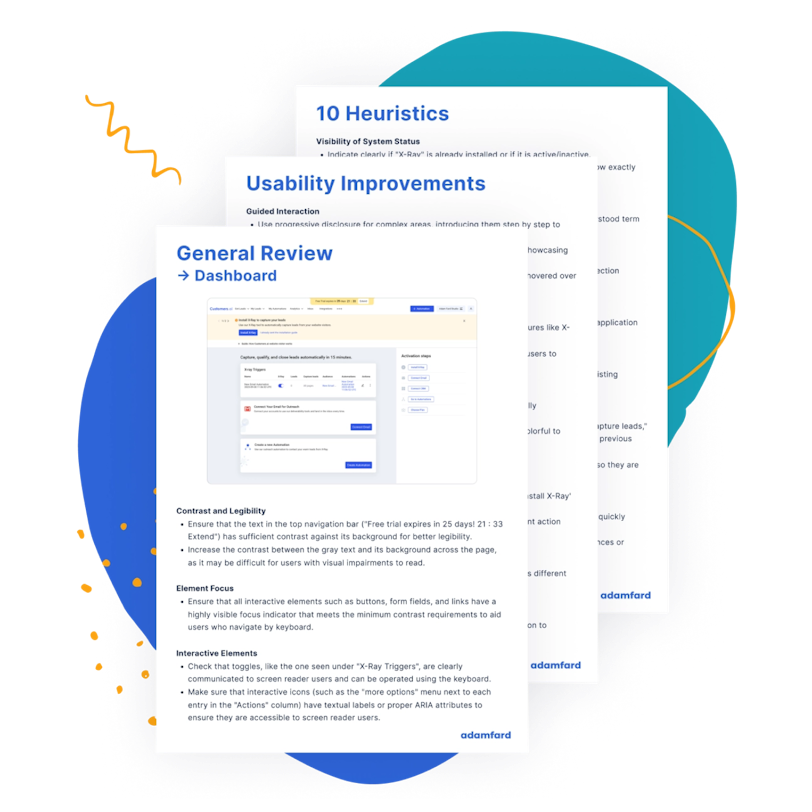There’s one big misunderstanding surrounding the topics of UX and SEO.
Many people think that SEO is all about link building and keywords.
While those two are the biggest aspects of all SEO practices, they’re just a part of what search engine optimization is all about.

Get an express UX Audit. Done in 24 hours.
Submit designs. Get a review the next day. It's that simple.
Try nowWhat Is UX and SEO?
Do you also think that SEO and UX design are not connected and can’t really be linked?
This is actually wrong and here is why.
It all starts with Google. To separate the bad from the good and to give users fast access to the best of the best, search engines constantly change their algorithms and SERPs.
SEO goes far beyond link building and keywords. It’s an entire process, a plethora of tools that aim for a better customer experience.
To improve your SEO, you need to pass Google’s tests, fit right into their quality checks, and optimize your online presence. That’s exactly what search engine optimization stands for.
But what does UX design mean?
User experience (UX) design is the process of appealing to people’s emotions and attitudes based on research and a variety of tools at a designer’s disposal. UX SEO is about making the user happy.
They have shared goals and purposes: to get the business to the customer and influence user behavior. Together, UI/UX and SEO can do wonders for a brand or a business.
The roles of UX designers combined with those of SEO experts make targeting and optimization the perfect way to promote a brand or service on the web. They might have different approaches and final goals, but the truth is, UI/UX and SEO complement each other.
You can’t possibly ask, “Does UX affect SEO?” without asking the very opposite:
Does SEO Affect UX?
The answer is yes, definitely. These two are complementary, which makes them crucial for business promotion.
SEO starts with the expertise to choose the right research method and produce the perfect keywords to use in the content. It goes beyond just keyword use. If you go online and search, “What are SEO best practices?” you’ll probably come up with endless answers, including link building, keyword optimization, and even voice search optimization, one of the latest additions to quality SEO works.
Expert Tip: Here's an in depth guide from Digital Estate covering 11 SEO Best Practices.
By doing research, SEO experts find ways to create content that will appear high in search results. This content is filled with keywords, tweaked to fit the intended audience, interlinked with other pages, and set to achieve a certain result. But this is just a piece of the big project.
Once the SEO expert’s work is completed, the job of making the online presence appealing to the user begins.
When an SEO expert positions the content high on Google and makes it visible, there’s another essential step to take if you want to keep the audience interested and basically, to beat the competition. This is where UX comes into play.
Why Is UX/UI Important for SEO and Website Ranking?
SEO prepares the field for what comes, and UX uses that to help turn visitors into leads.
If you have prepared and published the content and have people pouring onto your pages as a result of a good SEO strategy, then you’re probably wondering why UI and UX design is important for you.
Let me explain.
When the target audience gets to your website and lands on its pages, it is the UX that gives them the answers to their questions and the solutions to their needs.
The goal of UX design is to improve the user experience upon landing on the website. Without it, all SEO efforts collapse. What good is your customer presence if they don’t stick around to actually make your site successful?
The combination of UI UX SEO practices makes for the perfect solution to every problem. SEO prepares the field for what comes, and UX uses that to help turn visitors into leads.
Optimizing the elements mentioned below will make your website very valuable to both search engines and users. If you don't have time or need professional help, it's best to work with professional SEO agencies like Tactica, which will help you increase the visibility of the business website by applying the best practices for higher search engine rankings.
Using UX to Affect Your SEO: 5 Effective Methods
The most amazing evolutions for marketers happen with the right combination of UX and SEO. A mobile-friendly website and responsiveness can positively affect SEO. When you work on your website’s SEO, you focus on the search engines and the visitor.
But when you implement UX techniques, you focus on the visitor and the user experience. This is where the two overlap — and in a good way.
Now comes the best part. There are several UX strategies that can be used to improve your SEO. Here are what these strategies include:
1 - Language Research
The people within the industry and the target customers use a certain language. This doesn’t refer to an actual language, but a style and wording that are commonly used in the industry to describe and market similar services and products.
Determining this is an essential step for a combined UX SEO strategy so the content is a better fit to them.
2 - Simpler Website Architecture
According to Peter Morville and Louis Rosenfeld, two UX design experts, there are three circles that make up the information architecture:
content
user
context of use.
Once you have these, the job of a UX designer is to organize the website’s flow and the content based on planning and research.
The final goal is to come up with an ideal, simpler website architecture that balances the website’s goals with the user’s goals and desires.
3 - Reduced Page Loading Time
According to the 2018 research by Google, it takes three seconds for a person to leave your website because it takes its time to load.
As unfair and frustrating as this sounds, slow loading times can cost you over half of the users who find your pages on the web.
Thankfully, there are plenty of proven UX design tips that can fix this issue, including:
Avoid the use of obscure fonts.
Regularly audit your website to spot errors.
Make the rollover buttons/hover effects imageless.
Use accordions to segment the content.
Avoid parallax scrolling, especially if you are trying to optimize the site for mobile use.
Make sure all images are high quality and the proper size before you post them.
You can use the SEO Checker by Sitechecker to test page load times and find any problems that are affecting it.
4 - Intent Research
Not all keywords that show up during keyword research will have a good effect or carry the same meaning for the target audience. This is why you need to research intent too. You can use tools like LongTailPro for keyword research and intent research.
Users scour the web looking for solutions and answers. They often don’t even know exactly what they’re looking for, which can make this challenging for a marketer. Still, there is no doubt that intent is one of the most important parts of providing quality user experience.
Once you realize what the intent is, you need to translate those intents into a successful design decision. To do this, you should:
Find out where the user comes from and what they searched to reach your pages.
Learn their name (you could do this through social media sign-ups).
Find out about their previous interaction history by looking at their visits and behavior on your website.
5 - Getting Searchers to Click
SEO is what brought them to your website, but what will make them click on the call-to-action?
This can be accomplished by creating UX design that captures their attention and combines features that encourages them to click and take action.
If your grasp of UX principles is basic, teaming up with a local agency, such as a search engine optimization company in your local city, is a good move. Experts can help with every aspect efficiently.
Final Thoughts
In the world of online marketing, there will always be room for improvement. Naturally, you can’t be great at everything all at once.
SEO and UX is an iterative approach that starts with research, continues with design and implementation, is combined with consistent analysis, and goes back to research again. Implementing SEO and UX strategies into your website design won’t happen overnight.
Don’t be disappointed or lose motivation if your strategy doesn’t yield results right away.





